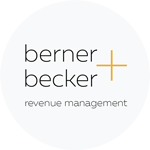Revenue management technology – a low, mid or high-tech approach?
Taking a walk through the E-travel halls of the major industry fairs like ITB in Berlin or WTM in London and seeing all the technology options available leaves many hoteliers perplexed. It is not easy to navigate through the selection process of these systems and knowing which of them to choose. In the field of revenue management, there is software ranging from simple dashboards to very complex full revenue management systems (RMS). Furthermore, many other systems like channel managers, rate shoppers and market share providers are closely linked to revenue management and play a vital part of its success in a hotel. To assist hoteliers to make the right selection I will in this article explain three different scenarios in which revenue management can be done with a low, mid and a high-tech approach.
Low-tech
Even the simplest price and yield strategy changes can make great impacts! Robert Cross (1997) tells us about his hairdresser example in his book “Revenue Management: Hard-core Tactics for Market Domination” where he always went on Saturdays, waiting in a long line. After a simple price increase on Saturdays the hairdresser got more revenue per hour in the chair on the weekends and at the same time a higher chair occupancy on weekdays as students and pensioners came then instead due the price difference. It was a win-win for all with shorter waiting lines and more revenue for the hairdresser.
In the same way hotels can make a big impact on bottom line results by implementing revenue management tactics with little to no technology. If the budget is low for such expenditures, hotels should focus on some of the basic processes that bring instant results. Here, my recommendation is to do a simple manual forecast and to look at booking patterns, and base your pricing and yielding on this analysis. The key is to measure the demand and set strategies accordingly.
My sister runs a beautiful little establishment on the popular summer island Öland in Sweden called Alvaret Hotel & Hostel. With its nicely renovated 9 rooms it’s not in need of sophisticated technology and she doesn’t even have a property management system (PMS). The only system she has is a simple channel manger so she doesn’t have to spend time on manually updating prices on all different selling channels. This channel manager gives some simple reporting and together with the direct incoming reservations we can easily see booking patterns and adapt pricing strategies accordingly, increasing her revenues by several thousands of euro.
Mid-tech
A bigger hotel with a higher budget for systems can take their revenue management practises to the next level. The mid-tech approach would be the minimum recommended for any hotel that wants to apply professional revenue management. This is where a hotel should make use of systems to save time and enable a more accurate decision-making process based on reliable data.
It starts with a good PMS and a 2-way channel manager to make sure prices and yield changes get distributed the way they should to all selling channels. From a revenue perspective, it is very important that the PMS can generate good data reports that can be used as a base for forecasting and decision making. Here you want to make sure that reports with daily on the books data can be generated per segment and down to the rate code level.
Other systems that facilitate daily work is a good rate shopping tool that can give you instant and accurate reports on competitor selling prices, as well as some of them nowadays have basic overall market demand information. If you want to take it one step further there are several more simple revenue dashboards as I’d like to call them. Such systems can collect competitor prices and other types of data that influence demand and based on that give pricing suggestions of the public BAR rate. Such systems also typically include very useful pick up reports.
Except for this a hotel with the mid-tech approach should make sure to apply forecasting and forecast daily numbers per segment. This gives a detailed in-depth picture of the future which serves as a base for pricing and yielding decisions, together with the help of the previously mentioned tools. Lastly, a hotel at this level should engage in market share reporting and thus measuring itself towards a competitor set.
The mid-tech approach is something we have implemented for many clients and seen great RevPar increases as a result!
High-tech
If the mid-tech approach saves time and enables a better decision making, the high-tech approach rather consumes time but in the end, enables a highly scientific revenue management approach that will yield the absolute highest impact in RevPar. I say consumes time here because these systems are not a plug and play and sit back and relax system. No, they require much input and management to work at their optimal level.
So, should all hotels do this? Well, the more hotel rooms you have in your hotel or hotel portfolio, and the more demand you have in your market, revenue management as such will have a bigger impact, and optimising it through a high-tech approach can then make huge impacts on the bottom line result.
Which systems are then included at this level? The most important one is a full-fledged RMS, and there are only a handful of those in the market which qualify as such. They have different strengths among them and it comes down to the individual needs of the hotel when choosing the right one. These systems have complex algorithms analysing market demand, make price and yield suggestions for public but also other segments. They complete in depth forecasting and group quotations through in-depth displacement calculations. Moreover, price and yielding changes can even be automated.
As those systems work with the concept of big data they can analyse data faster and more in depth than a human can and with that take instant decisions, making price and yield changes perfectly timed, ensuring no opportunities are lost.
RMS typically also include useful reporting tools which contain advanced pick up reports showing pick up pace, same point in time (SPIT) historical data, detailed account productions, day of week pattern analysis and much more. If not at hand, hotels should look in to having a good business intelligence (BI) tool to get sophisticated reporting. To some extent some of the more advanced PMS have this integrated. Also, you could consider some of the market intelligence tools available that give in-depth competitor information.
Most hotels within chains and other professional players work on this level and there is no doubt that these hotels consequently are reaching the highest RevPar and market share levels.
Furthermore, interesting to look at for hotels that seriously want to push direct bookings is to list their own website on meta search and actively work with their meta search software provider to best place their cost per click (CPC) spending. However, before that hotels should make sure to have a perfectly set up website, a powerful booking engine and drive further bookings with the help of website conversion tools. Lastly, you can also look at applying upsell tools to further increase your ADR through the sale of higher room categories
Summary
These systems are there to help hotels enhance their revenue management practises. As mentioned, the larger the portfolio and the better the location, revenue management as such will have a bigger impact and thus you should apply a more professional approach to revenue management. The use of technology will help you with this and the more sophisticated systems you use, the better the outcome. At the same time, the high-tech approach requires more knowledge in how to use the systems and time needs to be invested.
To remember also is that before a hotel chooses to go for a mid or high-tech approach, the base and foundation of revenue management processes must be set! Surely, you need to have a proper segmentation, rate set-up and distribution in place before you implement a RMS system that optimises it.
As the world and technology evolves, systems will continue to become more and more sophisticated and automated, further reducing the need of manual input. Consequently, this will enable hotels and revenue managers to work even more efficiently and further increasing bottom line results.
References:
Cross, R (1997) Revenue Management: Hard-core Tactics for Market Domination (1st Edition). New York: Bantam Doubleday Dell Publishing Group Inc.




